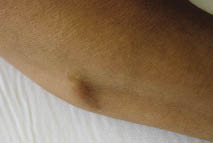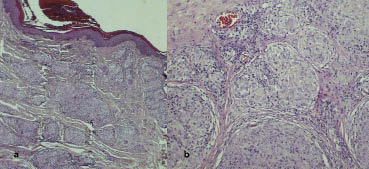Maria Rosaria Zampino1, Monica Corazza1, Alessandro Borghi1, Andrea Marzola2 and Annarosa Virgili1*
1Department of Clinical and Experimental Medicine, Section of Dermatology, and 2Department of Experimental and Diagnostic Medicine, Section of Pathological Anatomy, University of Ferrara, Via Savonarola 9, IT-44100 Ferrara, Italy. *E-mail: vri@unife.it
Accepted May 13, 2009.
Sir,
Sarcoidosis as a complication of interferon (IFN) administration was first described in 1987 in a patient with renal cancer (1). Since then, more than 50 cases of pulmonary and/or extra-pulmonary sarcoidosis, mainly occurring in middle-aged women, have been correlated with IFN-α therapy, sometimes associated with ribavirin, in patients with chronic viral hepatitis C (2, 3). Several lines of evidence suggest that HLA class I and class II alleles may be considered possible markers for susceptibility, clinical behaviour and prognosis of sarcoidosis (4, 5).
We report here a case of scar sarcoidosis that occurred one month after completion of a course of pegylated-IFN-α therapy for chronic hepatitis C virus (HCV) infection. HLA typing was performed to evaluate the potential role of an immunogenetic predisposition factor.
CASE REPORT
A 59-year-old woman was evaluated for a painless nodule that had developed slowly on her right forearm over the previous 2 months. Physical examination revealed a well-demarcated, hard, subcutaneous nodule, 4 cm in diameter, underlying a linear post-traumatic scar acquired during childhood (Fig. 1). The patient had previously undergone a 24-week treatment for active chronic HCV genotype 2a/2c, consisting of 180 µg of PEG-IFN-α, administered subcutaneously once weekly, and 800 mg/day of oral ribavirin. This treatment had had a successful outcome, leading to an undetectable viral load and an improvement in the results of liver enzyme tests by the fourth week of therapy. The treatment was completed one month prior to the appearance of the nodule.
Fig. 1. Subcutaneous nodule underlying a linear post-traumatic scar on the right forearm.
The nodule was surgically removed and the specimen was stained with haematoxylin and eosin. Histopathological examination revealed the presence of Langhans giant cells and sarcoidal-type, non-necrotizing, round, epithelioid granulomas in both dermis and hypodermis, circumscribed by peripheral fibrosis (Fig. 2).
The patient showed neither pulmonary symptoms nor other signs of systemic sarcoidal involvement. Chest X-ray and angiotensin-converting enzyme levels were negative. Ophthalmological examination and electrocardiogram revealed no anomalies.
Fig. 2. (a) Sarcoidal-type, non-necrotizing round epithelioid granulomas circumscribed by peripheral fibrosis (haematoxylin and eosin (H&E) ×4). (b) Langhans giant cells were observed (H&E ×10).
HLA class I and II alleles were analysed with a polymerase chain reaction technique with sequence-specific primers, and the patient was found to express HLA A*30, A*68, B*35, B*58, Cw*03, Cw*04, DRB1*03, DRB1*1001, DQB1*02, and DQB1*05.
DISCUSSION
Nowadays IFN-α is successfully used to treat numerous medical disorders, such as viral, malignant, angiogenic, inflammatory and fibrotic diseases. The addition of polyethylene glycol (PEG) to the standard IFN-α molecule (PEG-IFN-α) reduces the clearance rate of the protein from the blood, prolonging its half-life and permitting once-weekly administration. Ribavirin is now frequently used in conjunction with PEG-IFN-α in the treatment of chronic HCV, due to its synergic antiviral effect. Both PEG-IFN-α and ribavirin activate T-helper lymphocytes and promote development of the Th1-mediated response against viruses. Enhancing the Th1 immune response and macrophage activation, the main immunological events in the pathogenesis of sarcoidosis, may promote the formation of sarcoid granulomas after administration of IFN-α (6). The prevalence of IFN-α-induced sarcoidosis in patients with HCV has been approximated as 0.1–0.2%. However, it has been hypothesized that this figure may have been underestimated, as the systemic symptoms observed in patients with sarcoidosis, such as fever, fatigue and pulmonary involvement, are similar to the side-effects that can be induced by IFN-α administration (2).
Clinical manifestations of IFN-induced sarcoidosis can appear from as early as one month after administration of the drug is commenced to as late as 6 months after its withdrawal (3). The majority (roughly two-thirds) of cases of IFN-induced sarcoidosis arise during the first 6 months of IFN therapy, but clinical manifestations may also appear after discontinuation of the antiviral treatment, usually in the first 3 months (2). Pulmonary disease occurs in 76% and articular involvement in 20% of IFN-α-induced sarcoidosis cases, while ocular, hepatic or myocardial sarcoid lesions are very rare (2, 3, 7–9).
By contrast, cutaneous involvement in IFN-α-induced sarcoidosis is very common and occurs in approximately 60% of cases. This incidence is higher than that observed in non-drug-related sarcoidosis, where a prevalence of 25% has been reported (2). Cutaneous manifestations and respiratory involvement may simultaneously occur in up to 26% of patients (2).
Skin lesions are usually erythematous papules or nodules arising at the sites of drug injection, tattoos or old scars (2). Cases occurring at the sites of injection of resorbable or permanent facial fillers have also been recently reported (10).
Most IFN-induced lesions resolve spontaneously, over the course of a few months, following drug discontinuation, especially in patients with cutaneous localization of the disease; however, approximately 11% of cases, usually those with extracutaneous involvement, can have a chronic course and 6% may even reactivate after an initial improvement (2).
In recent years, several studies have lent weight to the theoretical association between HLA classes I and II and sarcoidosis, supporting the role of immunogenetic factors in the pathogenesis, clinical presentation and outcome of the disease (11, 12). A strong association between HLA-DRB1*03 and sarcoidosis has been reported, as well as a correlation of HLA-DRB1*03 and HLA-DQB1*02 with a favourable outcome of the disease (5, 13, 14). In contrast, other alleles, such as HLA-DRB1*15, significantly increase the risk of persistent sarcoidosis (11, 13, 14).
As HLA typing revealed that our patient was positive for HLA-DRB1*03 and HLA-DQB1*02, it may be hypothesized that this HLA profile predisposed the patient to IFN-induced sarcoidosis development. Indeed, the occurrence of a sarcoid-type granuloma at the site of an old scar, injection or tattoo may reflect the activation of a T-cell-mediated immune response towards exogenous materials persisting in the tissues induced by IFN-α therapy in genetically predisposed individuals.
Immunogenetic characterization of patients presenting IFN-induced sarcoidosis may perhaps contribute to the identification of those patients prone to developing mild or severe forms of sarcoidosis, allowing physicians to plan a suitable follow-up.
REFERENCES





